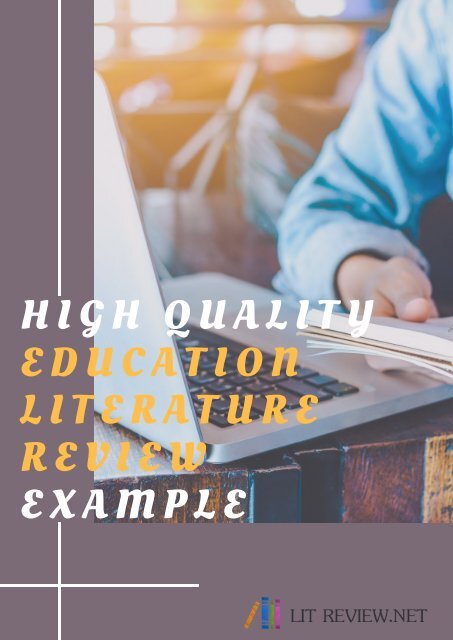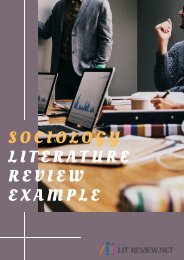high-quality-education-literature-review-example
We've prepared a great high-quality education literature review example! Look at the doc! More: https://www.litreview.net/
We've prepared a great high-quality education literature review example! Look at the doc! More: https://www.litreview.net/
You also want an ePaper? Increase the reach of your titles
YUMPU automatically turns print PDFs into web optimized ePapers that Google loves.
H I G H Q U A L I T Y<br />
E D U C A T I O N<br />
L I T E R A T U R E<br />
R E V I E W<br />
E X A M P L E
In one of the broadest definitions of <strong>education</strong> aimed at recognizing and<br />
affirming diversity as a social value that carries an invaluable pedagogical<br />
potential, Sonia Nieto (1999) determines intercultural <strong>education</strong> as a<br />
philosophy, a worldview, an open process involving relationships among<br />
people and discussing differences between complex systems social ideas<br />
and beliefs. The author emphasizes in particular the importance of<br />
multicultural competence and literacy in basic <strong>education</strong> as the basic skills<br />
that everyone needs to successfully deal with life challenges, not just<br />
culturally diverse or socially deprived students. He argues for his position<br />
with insufficient understanding of the differences, privileges and powers<br />
that often occurs in students from dominant groups and reflects on their<br />
(non) perception of their own cultural identity. Therefore, we can conclude<br />
that deep understanding of culture is at the very core of intercultural<br />
<strong>education</strong>, and it involves establishing a critical departure from one's own<br />
culture and its perception as unquestionable, as well as courage in trying<br />
to understand different cultures and their complex inter-relationships. We<br />
must therefore be aware that these efforts are a great challenge and that it<br />
may not be possible to fully realize them, but it is also imperative to<br />
establish pedagogical theories, models and practices aimed at overcoming<br />
the linguistic and cultural barriers (Coulby, 2006).<br />
This understanding of intercultural <strong>education</strong> as a concept intended for<br />
everyone, not just culturally diverse students, is one of the general settings<br />
that most authors agree with in this area. Common definitions of<br />
intercultural <strong>education</strong> concepts also include:<br />
Understanding of dialogue as a fundamental component of <strong>education</strong>;<br />
Understanding the hidden curriculum as an integral part of the<br />
<strong>education</strong>al process and<br />
A demand for deeper understanding of the culture and identity of pupils,<br />
which does not stop on the superficial understanding of differences<br />
based on external, visible features (such as skin color).<br />
This complex process of conceptualization of diversity, says Maxine<br />
Greene (1993), is one of the key elements in intercultural <strong>education</strong>.
Not to neglect the influence of global processes that significantly influence<br />
the more pronounced cultural heterogeneity of society, the author points<br />
out that there have always been other, different, foreigners in society. The<br />
fact that we notice them today more than ever before does not mean that it<br />
has not existed before, but speaks of the earlier (no) willingness to see<br />
them, which is corrected in today's society thanks to, inter alia, the system<br />
of human rights. What is happening in today's society, Greene (1993), is<br />
termed by interrupting old silence and by mocking voices that have long<br />
been mired.<br />
However, this process is very slow and demanding, especially when we<br />
talk about the practical implementation of guidelines that provide citizens<br />
with the right to <strong>education</strong> on an international and national level, including<br />
respect for their different cultures, traditions and identities. Namely, most<br />
European <strong>education</strong>al systems, Gundara (2000), are still shaped so as not<br />
to recognize the diversity sufficiently and reflect the wrong assumption of<br />
the existence of a unique, homogenous national culture. Education, the<br />
author emphasizes, is closely related to the hegemonic canon and<br />
imprisoned in a "cultural prison" that recognizes only its own, Eurocentric<br />
tradition that serves as a starting point for assessing the value of other<br />
cultures. In order for this to change, it is necessary to form an intercultural<br />
curriculum that reflects the richness of different cultural traditions and<br />
provides the area for the self-articulation from the perspective of its own<br />
cultural standards, not the ones that are dominated by the Eurocentric<br />
tradition. Namely, curricula that promote exclusively national values<br />
increase the feeling of exclusion and water on the demand for separate<br />
minority schools, and thus towards the deeper internal divide of society that<br />
appears on the surface as a simple problem whose solution lies in the<br />
position of "political correctness" which strives for superficial interventions<br />
conceal the structural causes of injustice and ine<strong>quality</strong> in society.<br />
The <strong>high</strong>lighted problems of Gundara (2000) sum up, citing the obstacles<br />
to the introduction of intercultural <strong>education</strong> in European Union countries.<br />
These are:
Lack of a systematic approach to the implementation of<br />
intercultural <strong>education</strong> in the European Union and across<br />
Europe;<br />
Understanding of intercultural <strong>education</strong> as a theoretical<br />
discussion at the academic level, without any real changes in<br />
the school system and the <strong>high</strong>er <strong>education</strong> system;<br />
The absence of a single model of intercultural <strong>education</strong> at EU<br />
level, despite the theoretical consensus on the need to develop<br />
a model for a future European society where intercultural<br />
<strong>education</strong> and the promotion of social diversity play an important<br />
role;<br />
Negligible influence of the international recommendations of the<br />
European Union and of the Council of Europe on the national<br />
<strong>education</strong> policies of European countries whose <strong>education</strong><br />
systems continue to be strongly influenced by political control....<br />
In addition to the above-mentioned external obstacles to the<br />
implementation of intercultural <strong>education</strong>, it is also important to point out<br />
the wrong interpretations of intercultural <strong>education</strong>, whose non-critical<br />
dissemination contributes to its "inward" distortion. For, as Gorski (2008)<br />
points out, the far greater problem of intercultural <strong>education</strong> than external<br />
attacks is internal problems.<br />
Different mistakes about intercultural <strong>education</strong> are slowing down its<br />
implementation and contributing to discussions of its definition and<br />
purpose. One of the most common mistakes related to intercultural<br />
<strong>education</strong> is that it is intended for "culturally diverse students", while the<br />
category of diversity is most often reduced to ethnic or national affiliation,<br />
that is, its most obvious manifestation - language. This is supported by the<br />
ad hoc approach to intercultural <strong>education</strong>, which is seen in enabling the<br />
cultivation of minority culture and languages for pupils attending the major<br />
schools, whereby it easily falls into the trap of cultural egoism, i.e. the<br />
intercultural <strong>education</strong> to the "mercy" of the majority culture that cares<br />
about minority culture and allows her life.
Furthermore, such an understanding of diversity relies on a simplified,<br />
static version of identity dominantly generated by ethnicity and remains<br />
insensitive to numerous other identity markers, such as gender, class,<br />
religion, sexual orientation or disability, on the one hand reinforcing<br />
prejudices about certain minority groups, on the other hand, the existing<br />
relationships of injustice and ine<strong>quality</strong> in society and the oppressive<br />
elements of the majority culture are in no way questioned.<br />
The next flaw is about integrating content, or understanding that<br />
expanding existing curricula with content on different cultural, ethnic and<br />
racial groups is the core of intercultural <strong>education</strong>. This flawed discussion<br />
of intercultural <strong>education</strong> focused primarily on the analysis of the content of<br />
a formal curriculum, such as the nature of canonical knowledge, while other<br />
important dimensions (reduction of prejudice, introduction of culturally<br />
responsive teaching and evaluation methods, critical recognition of<br />
teachers and students, transformation of school culture) neglected. In<br />
addition, focusing on the content dimension encouraged the expansion of<br />
quasi-intercultural teaching materials, textbooks and manuals, which in a<br />
superficial way, often only at the level of a colorful cover that shows<br />
children of different colors of skin in the smiling wheel, contribute to the<br />
perpetuation of the reductionist understanding of intercultural <strong>education</strong>.<br />
Furthermore, it is very common and a misconception about the dangers of<br />
intercultural <strong>education</strong> by social cohesion, that is, the understanding that<br />
opening up space for different voices and perspectives leads to social<br />
disintegration (Banks, 2002). However, empirical data shows the opposite.<br />
For <strong>example</strong>, the survey conducted in 2008 in 27 European countries has<br />
shown that unemployment and poverty are more significant indicators of<br />
tensions between the Muslim minority community and the majority<br />
community than they are ethnic or religious identity (Sharpes & Schou,<br />
2014), indicating the necessity of allocating responsibility for social<br />
cohesion among all social actors, not its exclusive locating in minority,<br />
especially Muslim communities, perceived as negligent in accepting the<br />
democratic values of the West and the threat to European national<br />
identities.
REFERENCES<br />
Nieto, S. (1999), Multiculturalism, social justice, and critical teaching. In:<br />
Shor, I., Pari, C. (ed.), Education is politics: critical thinking across<br />
differences, K-12: A tribute to the life and work of Paulo Freire. Portsmouth:<br />
Boynton/ Cook Heinemann, p. 1 - 32.<br />
Coulby, D. (2006), Intercultural <strong>education</strong>: theory and practice. Intercultural<br />
Education, 17 (3), p. 245 - 257.<br />
Greene, M. (1993), The Passions of Pluralism: Multiculturalism and the<br />
Expanding Community. Educational Researcher, 22 (1), p. 13 – 18.<br />
Gundara, J. S. (2000), Interculturalism, Education and Inclusion. London:<br />
Paul Chapman Publishing Ltd.<br />
Gorski, P. C. (2008), Good intentions are not enough: A decolonizing<br />
intercultural <strong>education</strong>. Intercultural Education, 19 (6), p. 515 - 525.<br />
Banks, J. A. (2002), An Introduction to Multicultural Education. Boston:<br />
Allyn and Bacon.<br />
Sharpes, D. K., Schou, L. R. (2014), Teacher Attitudes toward Muslim<br />
Student Integration into Civil Society: a report from six European countries.<br />
Policy Futures in Education, 12 (1), p. 48 - 55.





